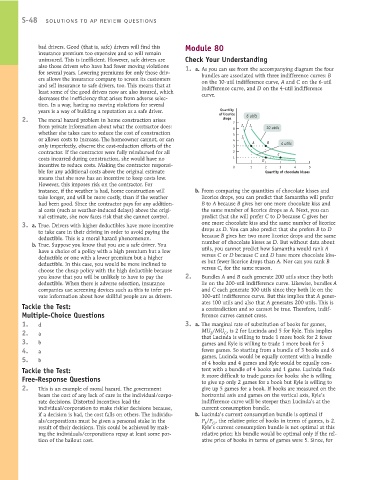Page 894 - Krugmans Economics for AP Text Book_Neat
P. 894
S-48 SOLUTIONS TO AP REVIEW QUESTIONS
bad drivers. Good (that is, safe) drivers will find this Module 80
insurance premium too expensive and so will remain
uninsured. This is inefficient. However, safe drivers are Check Your Understanding
also those drivers who have had fewer moving violations 1. a. As you can see from the accompanying diagram the four
for several years. Lowering premiums for only those driv- bundles are associated with three indifference curves: B
ers allows the insurance company to screen its customers on the 10-util indifference curve, A and C on the 6-util
and sell insurance to safe drivers, too. This means that at indifference curve, and D on the 4-util indifference
least some of the good drivers now are also insured, which curve.
decreases the inefficiency that arises from adverse selec-
tion. In a way, having no moving violations for several
Quantity
years is a way of building a reputation as a safe driver. of licorice
2. The moral hazard problem in home construction arises drops 6 utils
7
from private information about what the contractor does: 6 I 2 I 3 10 utils
whether she takes care to reduce the cost of construction 5
or allows costs to increase. The homeowner cannot, or can 4 I 1
only imperfectly, observe the cost-reduction efforts of the 3 A B 4 utils
contractor. If the contractor were fully reimbursed for all 2 C
costs incurred during construction, she would have no 1 D
incentive to reduce costs. Making the contractor responsi- 0 1 2 3 4 5
ble for any additional costs above the original estimate Quantity of chocolate kisses
means that she now has an incentive to keep costs low.
However, this imposes risk on the contractor. For
instance, if the weather is bad, home construction will b. From comparing the quantities of chocolate kisses and
take longer, and will be more costly, than if the weather licorice drops, you can predict that Samantha will prefer
had been good. Since the contractor pays for any addition- B to A because B gives her one more chocolate kiss and
al costs (such as weather-induced delays) above the origi- the same number of licorice drops as A. Next, you can
nal estimate, she now faces risk that she cannot control. predict that she will prefer C to D because C gives her
one more chocolate kiss and the same number of licorice
3. a. True. Drivers with higher deductibles have more incentive
to take care in their driving in order to avoid paying the drops as D. You can also predict that she prefers B to D
deductible. This is a moral hazard phenomenon. because B gives her two more licorice drops and the same
b. True. Suppose you know that you are a safe driver. You number of chocolate kisses as D. But without data about
have a choice of a policy with a high premium but a low utils, you cannot predict how Samantha would rank A
deductible or one with a lower premium but a higher versus C or D because C and D have more chocolate kiss-
deductible. In this case, you would be more inclined to es but fewer licorice drops than A. Nor can you rank B
choose the cheap policy with the high deductible because versus C, for the same reason.
you know that you will be unlikely to have to pay the 2. Bundles A and B each generate 200 utils since they both
deductible. When there is adverse selection, insurance lie on the 200-util indifference curve. Likewise, bundles A
companies use screening devices such as this to infer pri- and C each generate 100 utils since they both lie on the
vate information about how skillful people are as drivers. 100-util indifference curve. But this implies that A gener-
Tackle the Test: ates 100 utils and also that A generates 200 utils. This is
a contradiction and so cannot be true. Therefore, indif-
Multiple-Choice Questions ference curves cannot cross.
1. d 3. a. The marginal rate of substitution of books for games,
2. a MU /MU , is 2 for Lucinda and 5 for Kyle. This implies
B
G
3. b that Lucinda is willing to trade 1 more book for 2 fewer
games and Kyle is willing to trade 1 more book for 5
4. a fewer games. So starting from a bundle of 3 books and 6
5. b games, Lucinda would be equally content with a bundle
of 4 books and 4 games and Kyle would be equally con-
Tackle the Test: tent with a bundle of 4 books and 1 game. Lucinda finds
Free-Response Questions it more difficult to trade games for books: she is willing
to give up only 2 games for a book but Kyle is willing to
2. This is an example of moral hazard. The government give up 5 games for a book. If books are measured on the
bears the cost of any lack of care in the individual/corpo- horizontal axis and games on the vertical axis, Kyle’s
rate decisions. Distorted incentives lead the indifference curve will be steeper than Lucinda’s at the
individual/corporation to make riskier decisions because, current consumption bundle.
if a decision is bad, the cost falls on others. The individu- b. Lucinda’s current consumption bundle is optimal if
als/corporations must be given a personal stake in the P /P , the relative price of books in terms of games, is 2.
G
B
result of their decisions. This could be achieved by mak- Kyle’s current consumption bundle is not optimal at this
ing the individuals/corporations repay at least some por- relative price; his bundle would be optimal only if the rel-
tion of the bailout cost. ative price of books in terms of games were 5. Since, for

